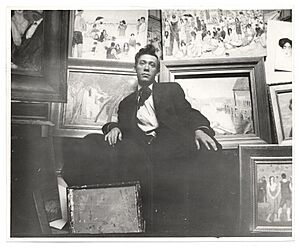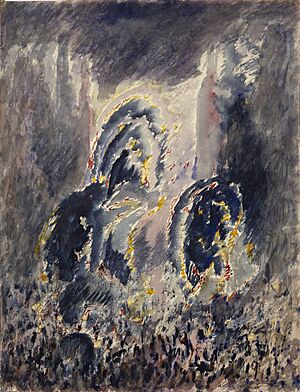Abraham Walkowitz facts for kids
Quick facts for kids
Abraham Walkowitz
|
|
|---|---|
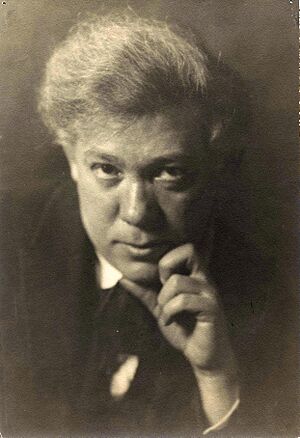
Walkowitz in 1917
|
|
| Born | March 28, 1878 Tyumen, Russia
|
| Died | January 27, 1965 (aged 86) |
| Nationality | American |
| Education | National Academy of Design, Académie Julian in Paris under Jean-Paul Laurence |
| Known for | Painting |
| Movement | American Modernism |
Abraham Walkowitz (born March 28, 1878, in Tyumen, Russia; died January 27, 1965, in New York City, USA) was a Russian-American painter. He was part of the early American Modernist art movement. Even though he might not be as famous as some other artists from his time, Walkowitz was very important. He worked closely with the 291 Gallery and Alfred Stieglitz, a famous photographer. This put him right at the heart of the Modernist art world. His early abstract paintings of cities and his huge collection of over 5,000 drawings of the dancer Isadora Duncan are still very important in art history.
Becoming an Artist
Abraham Walkowitz was born in Tyumen, Siberia, Russia. His family was Jewish. When he was a young child, he moved to the United States with his mother.
He studied art at the National Academy of Design in New York City. Later, he went to the Académie Julian in Paris, France. There, he learned from a teacher named Jean-Paul Laurens.
Walkowitz and other artists became friends with the photographer Alfred Stieglitz. They often met at Stieglitz's 291 Gallery in New York. This gallery was a very important place. It was where many new ideas in American art began. It also showed European artists for the first time in the United States. During these years, Walkowitz worked closely with Stieglitz. He also worked with other famous artists like Arthur Dove, Marsden Hartley, and John Marin. These artists were sometimes called "The Stieglitz Quartet."
Early Art Journey
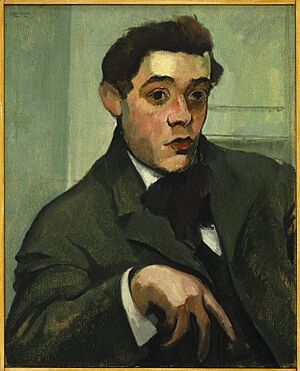
Walkowitz loved art from a very young age. He once said that when he was about five years old, he would draw everywhere with chalk. He felt that art was always a part of him.
When he was a young adult, he worked as a sign painter. He also started sketching immigrants in New York's Jewish neighborhoods. This is where he lived with his mother. He kept studying art. In 1906, a friend helped him get money to travel to Europe. He went to the Académie Julian in Paris.
In Paris, he met Isadora Duncan in Auguste Rodin's art studio. Duncan was a modern American dancer. She was very famous among new and experimental artists. Walkowitz was so inspired by her that he made more than 5,000 drawings of her.
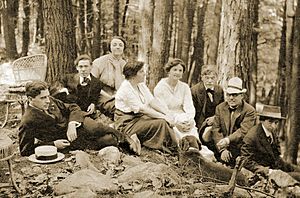
During these years, Walkowitz's art was influenced by European Modernist ideas. These ideas were about abstract art. They were slowly becoming popular in America. Like many artists, Walkowitz was greatly influenced by the work of Paul Cézanne. He saw Cézanne's art in Paris in 1907. Artist Alfred Werner said that Walkowitz found Cézanne's paintings to be "simple and intensely human." Walkowitz worked with other American Modernists who were supported by Stieglitz. He improved his art style and created many abstract works.
Walkowitz was careful not to just copy other artists. He wanted his art to be his own. Artist and critic Oscar Bluemner noticed this. He said that Walkowitz's art came from an "inner necessity." This meant Walkowitz created art from his own feelings and ideas.
Walkowitz first showed his art at the 291 gallery in 1911. Marsden Hartley introduced him to Alfred Stieglitz. Walkowitz stayed with the gallery until 1917. In those years, modern art was not always popular in America. Many people did not understand or like the new ideas from Europe. This changed after the important Armory Show in 1913. Walkowitz was part of this show and displayed his art there.
Drawings of Isadora Duncan
Isadora Duncan was a very important dancer. She changed how people thought about dance. She moved away from strict ballet rules. Instead, she explored movement through her own feelings and ideas. She wanted her dance to show the "divine expression of the human spirit." For Duncan, dance was a personal way to show beauty through movement.
Abraham Walkowitz was one of many artists who loved Duncan's new style of movement. His thousands of drawings of Duncan were a great way for him to show his own art ideas. He and Duncan shared similar thoughts about art and beauty. He could draw the same person many times and find something new in each drawing.
Duncan's dance often looked like classical sculpture. It showed the body in a beautiful pose, ready for more action. Walkowitz's drawings captured this feeling. He wanted to record the "keynote" of an experience. This meant he wanted to show the feeling or idea behind something, not just how it looked.
His drawings of Duncan show her body in motion. The lines in his art show the dancer's movements. Duncan herself wrote about dancers who make their bodies "luminous fluidity." This means they let their bodies flow with the soul's inspiration. This idea fits perfectly with Walkowitz's art.
Walkowitz continued to draw Duncan even after she died in 1927. His works show how much he believed in modern art. He also believed in breaking away from old traditions. In 1958, Walkowitz said that Duncan "had no laws." She created her own rules. He compared her to Walt Whitman, a famous American poet. Walkowitz called Whitman's book, Leaves of Grass, his "Bible."
Later Life
Abraham Walkowitz died at his home in Brooklyn, New York. He was 84 years old. This was on January 27, 1965. He was buried in Mount Lebanon Cemetery in Glendale, Queens.
Images for kids
-
Portrait of Abraham Walkowitz by Max Weber, 1907. This painting is at the Brooklyn Museum.
-
A group of artists in 1912. From left to right: Paul Haviland, Abraham Walkowitz, Katharine N. Rhoades, Emily Stieglitz, Agnes Ernst, Alfred Stieglitz, J. B. Kerfoot, John Marin.


